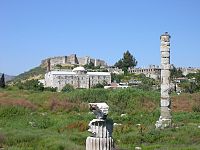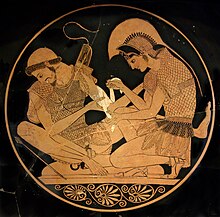Ancient Greek art
The art of Ancient Greece is the style developed by ancient Greek artists, characterized by the search for «ideal beauty», recreating the "ideal world" of the Platonic model, or through the "imitation of nature" in the sense of Aristotelian mimesis.
The culture developed by the ancient Greeks laid the foundations of Western culture. From this, the concepts and principles of art, philosophy and subsequent knowledge arose. Greek art begins autonomously at the end of the Mycenaean civilization, around 1100 BC. C..
Art historians generally define Ancient Greek art as art produced in the Greek-speaking region between the X century a. C. and the I century d. C. and generally exclude the art of the Minoan and Mycenaean civilizations, which existed between the 15th century and the XII a. C. although they have been Greek-speaking cultures, there is no continuity —or there is very little— between the art of these civilizations and later Greek art. Instead of the naturalistic plant representations of the Mycenaean period, designs with geometric lines appear and only later did they return to the representation of animals and people with schematic forms. He went through various periods, drawing inspiration from earlier civilizations such as Egypt and Mesopotamia, but always with new creations.
The earliest art of the Greeks is generally excluded from Ancient Greek art, and is instead known as Neolithic Greek art followed by Aegean art; the latter includes Cycladic art and the art of the Minoan and Mycenaean cultures of the Greek Bronze Age. The art of ancient Greece is generally divided stylistically into four periods: the Geometric, the Archaic, the Classical, and the Hellenistic. The Geometric age is usually dated to around 1000 BC, although little is actually known about art in Greece during the previous 200 years, traditionally known as the Dark Ages. The VII century BC. C. witnessed the slow development of the Archaic style, as exemplified by the black-figure style of Greek pottery. Around 500 B.C. C., shortly before the start of the Medical Wars (480 to 448 BC), is usually taken as the dividing line between the Archaic and Classical periods, and is considered to be the reign of Alexander the Great (336 to 323 BC)..) separates the classical and Hellenistic periods. As of the I century a. C. the term Greco-Roman is used, or more locally for the Eastern Greek world.
Actually, there was no sharp transition from one period to another. Art forms developed at different rates in different parts of the Greek world, and as in any age, some artists worked in more innovative styles than others. Strong local traditions and the requirements of local cults allow historians to trace the origins of even works of art far from their place of origin. Greek art of various kinds was widely exported. Throughout the period there was a general and steady increase in prosperity and trade links within the Greek world and with neighboring cultures.
The survival rate of Greek art differs markedly. We have large amounts of pottery and coins, much stone sculpture, though even more Roman copies, and a few large bronze sculptures. Almost all of the missing pieces are paintings, fine metal vessels, and anything in perishable materials, including wood. The stone shell of several temples and theaters has survived, but little of their extensive decoration.
Greek painters and sculptors acquired their technique through apprenticeships, often started by their father and protected by wealthy patrons. Although some were celebrated and admired, they did not have the same social status as the poets or playwrights of the same era. It was from the Hellenistic period, after 320 BC. C., when artists began to be recognized as a fully-fledged social category.
Periodization
Art historiography has identified several styles that periodized the art of Ancient Greece:
- Geometric (siglos) IX and VIIIa. C.); there are very few data from the previous period, known as the Dark Age, which preceded the art of pre-helmenical civilizations (cyclical art, minoid art and micenic art)
- Orientalizing (end of the centuryVIII and beginnings VIIa. C.)
- Arcaico (siglos) VII and VIa. C.), in the pictorial decoration of ceramics is characterized by black figures.
- Sever (finals of VI and beginnings Va. C.), in the pictorial decoration of ceramics is characterized by the bilingual vessels.
- Classic (siglos) V and IVa. C). —from the Medical Wars to the reign of Alexander the Great — in the pictorial decoration of the ceramics is characterized by the use of the red figures, which extends in the later period.
- Hellenistic (end of the century)IV and centuries III and IIa. C.), prolonged by Roman art from the Roman conquest of Greece (146 B.C.).
The art of archaic Greece (VII-VI BC)
The Archaic period begins at the end of the 8th century BCE. C. and covers until the beginning of the century V a. C. In this period there is an expansion of the Greek polis, establishing a new citizen order, with tyranny as the main political framework, a system that will soon disappear in the face of the egalitarian ideal of citizenship of the century V a. C. The legitimization of this type of citizen mandate supposes the promotion of great public works, representative of the prestige of the tyrant, who supports the creation of civil and religious buildings in the cities where he governs, for which he orders the remodeling of his urban fabric.. This action was intended to give each city its own identity, while showing its preponderance over the rest of them. Consequently, at this stage art plays a new propaganda role for tyranny, whose rulers use it to justify their barely legitimized power. From the VI century BC. C. the political center of the polis becomes a place of great artistic relevance, turning the public square or agora into the heart of the civic activities of society. Among all of them, that of the city of Athens stands out, promoted by the legislator Solon and monumentalized in the time of the Pisistratids.
Religious worship also played a fundamental role in the Greek society of this period, so that all those cities that had sufficient economic means promoted the construction of religious stone buildings, which played an important role when it came to unite the different classes of the new society, less egalitarian than that of previous centuries. Panhellenic sanctuaries are now created, such as Delphi and Olympia, where the various tyrants make large votive offerings to display their power, and new popular cults are fostered, while myths related to local gods and heroes arise, increasing the political identities of the different polis that need to feel independent and stand out from the rest.
Style

Architecture
Greek architecture fixed the forms of the temple, which developed in the acropolis (ακρόπολις) or raised citadels of each city; as well as in the Panhellenic sanctuaries. The proper panhellenikós (πανελληνικός -"of all the Greeks"-), celebrated games (agóns αγώνες -"contest", & #34;challenge", "dispute"-), where athletes and charioteers competed on behalf of their cops, in a sublimation of violence in the sacred that turned the victors into heroes or demigods, for what they acquired the right to be represented in statues; and they accumulated rich offerings, kept in luxurious buildings, built at the expense of each polis (the thesaurós θησαυρός). Although there were many other games in honor of other divinities or in other polis (such as the Panathenaics in Athens), four stood out, not because of the prize offered (some olives, or a crown of laurel leaves), but because of the prestige it gave. the periodic concurrence (every two or four years) of people from all over Hellas: that of Apollo in Delphi (where the oracles of Dodona were held), that of Zeus in Olympia (of which only ruins remain, where the Olympic Games were held), that of Poseidon in Isthmia (of which only the foundations remain, where the Isthmian Games were held) and that of Zeus in Nemea (of which there are some remains from the Hellenistic period, where the Nemean Games were held). Without being strictly panhellenic, other sanctuaries also achieved enormous prestige throughout Hellas: that of Hera on Samos (Ἥραιον, Heraion, the first great example of the Ionic order -Reco and Theodore of Samos-, where the ecclesiastical hierogamy ἱερός γάμος was celebrated) or that of Artemis in Ephesus (Ἀρτεμίσιον, Artemision, the second great example of the Ionic order, which entered the catalog of the seven wonders of the world).

The list of important temples would be endless (temple of the Muses on Helicon—in fact, all of Mount Helicon was dedicated to them, just like Mount Parnassus, but in a more tangible way than the way the Mount Olympus was to the main gods—, temple of Demeter in Eleusis, temple of Apollo in Didyma, temples of Poseidon —in Halicarnassus, in Aege, in Calauria, in Athens—, temple of Artemis —in Carje, in Sparta—, temples of Aphrodite —in Cnidos, in Lindos, in Cytherea—, temples of Hermes —in Imbros, in Samothrace, in Lemnos—, temples of Hera —in Mycenae, in Argos, in Phigalia, in Sparta—, temple of Ares in Sparta, temples of Dionysus —in Naxos, in Chios, in Athens—, temples of Asclepius —in Cos, in Epidaurus, which would achieve much greater prestige in later times—), some of them forming a defined spatial relationship, such as the &# 34;Sacred Triangle" between the Parthenon (Παρθενών -temple "of the virgin", that is, of Athena-, on the Acropolis of Athens), the Soúnion (Σούνιονy, on the promontory from which Aegeus threw himself into the sea) and the temple of Afaia in Aegina.
The shape of the Greek temple derived from the Mycenaean megaron (μέγαρον): essentially a rectangular plan covered with a gabled roof, with wooden structural elements. With the same structure, remains of a Dark Age temple have been found in Lefkandi (Euboea), and the first found remains of the Heraion of Samos (mid-century VIII BCE) are similar. The "petrification" of the elements of the temple was produced gradually (columns -whose shaft maintains the vegetal memory with the grooves or grooves-, beams -which produce the external finishes of triglyphs and metopes-, architraves, cornices, etc.), being the example most evident the Heraion of Olympia (ca. 600 BC). One of the reasons that prompted the change was the generalization of ceramic tiles replacing the covering of straw and branches, and that occurred in Corinth in the VII century BC. C. One of the first was the Thermon (Θερμον, temple of Apollo in Thermos, Aetolia, around 630 BC)). The weight, much higher, made it necessary to reduce the slope of the roof, and ended up defining the final proportions of the pediment that are so harmonious. In the different areas of Hellas, the Doric (more sober and solid) and Ionic (more slender and decorative) styles were defined.
Sculpture
Ε θ' הαλειφθεισ' ςς γαλμ' α'θις πάλιν
α σχιον ειδος λαβον στο κα καλοI wish I could, erased like a statue,
disappear my beauty and have a nasty look!HelenaEuripides.
Greek sculpture from the archaic period, strongly influenced by Egyptian, was characterized by original features, such as the aeginetic or archaic smile (so called because it is displayed on the figure of a famous dying warrior in the Temple of Afaia on Aegina); that were transformed, at the end of the period (last decades of the VI century and first of the V B.C.), in a style of transition to classicism called severe style, finally stimulated by the need to renew the sculptural decoration of the temples destroyed during the Persian invasion. The male (kuroi, singular kuros κοῦρος) and female (korai, singular kore κόρη) figures could represent both human beings and gods, a sign of their anthropomorphization and their elevation to the semi-divine or heroic rank (particularly, of the prestige achieved by the victors in the Panhellenic games).
The first sculptures were the xoana (ξόανα, singular xoanon ξόανον), made of wood, highly simplified representations of the human body adapted to the cylindrical shape of the trunk of a tree. They were replaced by figures carved in marble (especially prestigious was the Pentelic quarry) and bronze castings. Given the possibility of reusing this expensive material, very few have been preserved. Of much lower cost were the terracotta figurines, which were produced on an industrial scale, using moulds.
In addition to the textural possibilities offered by the different materials and finishing techniques, used to a limited extent in the archaic period, it was the polychromy applied to the sculptures that endowed them with luminosity and a sense of life. The ancient Greeks would not have conceived of a sculpture being left unpainted, they would consider it imperfect or unfinished. Even the inevitable loss of colors over time, which romantic taste considers an increase in aesthetic interest, was considered essential deterioration.
| Transition fronts of the archaic style to the classic |
Ceramics and painting
After an initial geometric period (centuries IX and VIII BC), which was followed by an orientalizing period (VII centuries). and first half of the VI BC) in which the influence of Assyria and other civilizations of the Ancient East (Due to the importance and diffusion that the Corinthian workshops reached at this time, they speak of the Proto-Corinthian style); Greek pottery evolved its forms, which towards the end of the VI century a. C. reached a high degree of expressive refinement, responding to a wide range of refined needs of the daily life of the upper classes, and the demand for luxury products easily exportable to the entire Mediterranean area, and even to distant places in the center of Europe.
Production in many of the colonies founded in those centuries was as important as that of the metropolises. In addition, the influence of Greek ceramics was felt in the local production of indigenous peoples, especially in Etruscan ceramics (which have truly syncretic typologies, such as the Ceretan hydria or Caere hydria) or in ceramics iberian.
Extensive use was made of the possibilities that the different types of vessels offered in certain parts of their surface (bottoms of the cups, bellies and necks of the amphoras, etc.) to act as a support for Greek painting, which was expressed successively in two main styles, called "black-figure ceramics" and "red-figure ceramics".
Each local school of ceramics was distinguished by a characteristic local style, although they influenced each other.
It began to be common for potters and, less frequently, painters to sign their works (Clytias, Exequias, Psiax, Euphronio), which is interpreted as a social assessment of their work, implying a very modern concept of function of art and of the artist, at a time when manual work was degrading in its consideration, linked to that of slaves. It is usual that only the name of the potter is known, with which the painter is named after him (Andocides Painter, Amasis Painter, Antimenes Painter, Taleides Painter). On other occasions it has only been possible to establish the common identity of a master by their works (Priam Painter, Nessus Painter, Horse Head Painter, Achelous Painter) or by the places where they have been found (Master of the Dipilon) or the museums and private collections where they are kept (Master or Painter of Madrid, Master or Painter of Princeton, Master or Painter of Edinburgh, Master or Painter of Rycroft, Master or Painter of Castellani). Some are grouped by their common characteristics (Little Masters, Leagrus Group, Perizoma Group, Three Lines Group, Pioneer Group -the latter already at the beginning of the century V BC-).
There was also painting on panels and walls, which has not been preserved except for very few remains, such as the Pitsa Panels (discovered in a cave in Sicyon, a town in the north of the Peloponnese, near the Gulf of from Corinth, where tradition considered that panel painting had been invented -pinax πίναξ, plural pinakes πίνακες, from which the word "pinacoteca" -). or the frescoes of the Tomb of the swimmer, in Posidonia (Magna Graecia). The Etruscan influence of this tomb is evident; although in turn Etruscan painting had received a notable Greek influence during the VII and VI a. C..

Chatos, niggers: so the Ethiopians see their gods.With blue eyes and blonds: so see their gods the tracios.
the forms of the divine bodies according to their own image: each according to his own.
But if the oxen and the horses and lions had hands,
hands like people, to draw, to paint, to create a work of art,
Then the horses would paint the gods like horses, the oxen
like oxen, and from their figures they would createJehophanes, Fragments 15 and 16.
Vestiges
Ancient Greek art has endured in the form of sculpture and architecture; also in minor arts such as the design of coins, the engraving of pottery and gems.
Painting
The Greeks, like most European cultures, considered painting to be one of the highest forms of art. The works of Polygnotus of Thasos, who worked in the 5th century B.C. C., they continued to be admired even 600 years after his death, as later happened with those of Leonardo da Vinci or Michelangelo, however in this case not only have none of his works been preserved but also no reproduction.
Greek painters generally worked on wood panels, which deteriorated quickly (starting in the IV century B.C..), when they were not well protected. Today there is almost no piece of Greek painting left, except for some remains of terracotta paintings and some paintings on the walls of tombs, mainly in Macedonia and Italy. Of the masterpieces of Greek painting we have only a few copies made in Roman times, most of them are of inferior quality.
Prior to the formation of Greek art itself, there was an art in ancient Greece that has been called pre-Hellenic, preserved only in the ruins of buildings of the time and on stucco, representing landscapes, war actions and courtly or religious ceremonies whose figures, although imperfect, reveal remarkable expression and life. In the vase decorations the human figure is rarely presented and always stylized and with few details.
As for Greek painting, the knowledge of its artists is due almost entirely to ancient historians, since not a single painting of it is preserved nor is there any known work by the famous Zeuxis, Parrhasius and Apelles, considered since ancient times the painters par excellence. The Greek pictorial works that are currently known and preserved consist solely of decorations on amphoras and other elegant vessels, except for some pavement mosaics and painted clay plates, and without counting the Roman painting works in which the Greek hand intervened. It is clear, however, that the Greeks painted excellent pictures, at least murals (copies of which may be some decorations of the large luxury amphoras) and that they used fresco, encaustic, tempera and perhaps oil procedures. The subjects represented in such paintings, judging by what is observed in the aforementioned vessels, were scenes of human life and traditions or mythological and heroic legends.
The architecture
The vast majority of Greek buildings have not survived, due to various reasons: they were destroyed in wars, looted for building materials, or struck down by earthquakes. Only a handful of temples, such as the Parthenon and the Temple of Hephaestus in Athens. Of the four wonders of the world created by the Greeks which none of them have endured:
- The statue of Zeus in Olympia.
- The temple of Artemisa in Ephesus.
- The Colossus of Rhodes.
- The Lighthouse of Alexandria.
The Greek Temple
Ancient Greece excelled in architecture. Temples are the most representative construction of Greek architecture, since their main purpose was to provide protection or shelter for a deity or god. On the inside was the effigy of the deity, while on the outside he was worshiped. The Greeks used the religious pretext to justify with this their great creations in this way they could unleash their imagination and create wonderful structures. Considered as a sublime architecture, this served as an example for the construction of other Greek structures; This is why Greek buildings share similar characteristics.
The main difference between the archaic temple and the pre-Hellenic temple is that it becomes the soul of the city, that is, before the palaces were, in turn, refuges for citizens in case of war, in the archaic era they were the sets of temples, that is to say the acropolis, is the house of the god and the refuge of the citizens, since they were located on a hill and were also fortified, probably for the utilities of before.
The ceremonies, whatever their importance, are performed outside the temple so that the smell of the sacrifices would reach the divine statue so that it would thank them and give them good harvests, etc.
At first the temples are very small and barely distinguishable from a house, but over time, in addition to the replacement of soft elements by rocks or ashlars, orders are established: the Doric, the Ionic and the Corinthian are the three orders, the first two arise at the beginning of the time while the Corinthian originates after deriving from the Ionic. In addition, Greek architecture is linteled or architraved by the beam that is placed in the portico called lintel. Ignore arches and other types of architecture.
- The plant: The temple is accessed by the porch, which is between two columns, which leads to the room that shelters the god (cella), which leads to the oysterthodmos, sealed place where the treasure of the temple is located, although sometimes it can be accessed from the outside.
If the temple is surrounded by columns, it is called peripteral and if the columns are limited to the portico, it is called prostyle, depending on the columns that the portico has, it will be distyle (two columns), tetrastyle (four), and so on. successively always being even.
- The doric order: it has as its base three steps the first two downwards called stereobates and the first up called syrup. It has no base and the diameter of the fuse is smaller from the styling to the capital, but it is not regular since it is abomb in the center (entasis). The separation between the fuse and the capitel is the collar, which gives the equine, which is the main core and has a plate shape, and then gives the abacus, which is a rectangular prism. Above the abacus is placed the arquitrabe, which is a beam that binds the two columns, which then holds the tape, which is a thin ribbon, and the tails, which are triglyphs cut. The frieze is composed of triglyph and metopa, the mútules are already mentioned before triglyphs cut, and the geison is an alero that marks depth in the fronton the triangular delimitation of the roof in the temple and that makes possible the fronton is the sima.
- The jonic order: it has the same base and is added an element that allows to decorate the fuse, the base. The fuse receives the same treatment as in the jonic except in the entasis, as it does not have. The capitel, although it can be more composite, is decorated with volutes, and the necklace becomes part of the capital and is not given as much importance as before.
The architrave starts to have three horizontal bands called fasciae and each one exceeds its immediate inferior. The frieze is a smooth space dedicated to making sculptures in it. The other elements are the same as the Doric.
Sculpture
All the sculptures and architecture that have survived are only a small sample of the immense collection of Greek works. Many sculptures of pagan gods were destroyed during the Christian era. Unfortunately, when marble is calcined, lime is produced, and this was the fate of many Greek marble works during the Middle Ages. During the same period, due to the scarcity of metals, most bronze statues were cast. Currently, many of the works that we have today are Roman copies.
Ancient Greek sculpture reached the ideal of artistic beauty as far as human ingenuity could go on its own. Although Greece flourished in all the Fine Arts, none distinguishes it more than sculpture.
He cultivated the art of Ancient Greece in all genres of sculpture, adopting with predilection marble and bronze as sculptural material and taking mythological and warriors as main subjects, to which he added in his last period the portrait of historical figures.
The expression of idealized reality, the regular organic proportion, the distance from the vague and monstrous, the precision in the contours and details, the harmony and beauty in the forms and the fineness in the execution.
Sculpture Division
Greek sculpture is usually divided into four well-defined historical periods, preceded by the protohistoric or Minoan and Mycenaean periods. In this, it developed for about twenty centuries (from the year 3000 BC to 1100 BC approximately) a rudimentary art but full of life and movement that modeled clay and worked stone, ivory, bone and even gold, lead and bronze, producing relief, engravings, mythological carvings in fine stones and small statues and idols. Although carved with a certain coarseness, they are sometimes presented with admirable correctness in the drawing that seems to recall the art of the reindeer hunters who may have had some historical link with the Aegean civilization.
The four archaeological periods that, after a prolonged artistic silence, followed the Mycenaean period are distinguished as follows:
- The training periodfrom approximately 620 to 540 BC. C.;
- The archaic periodfrom 540 B.C. to 460 B. C.;
- The period of perfection or classicuntil the end of the centuryIVa. C.;
- The period of disseminationsome call decay, after Alexander the Great until the conquest of Greece by Rome, from 323 B.C. to 146 B. C.
Other arts
From the archaic period of Greek art, painted ceramics and sculptures are almost the only art forms that have survived. Painting was in its infancy during that period, and no example has survived. Although coins were invented in the 7th century B.C. C., were not common in most of Greece until the V century BCE. c.
Ceramics
From this period stands out the elaboration of ceramics for daily use, or for funerals, where large vases were used. These vases were ornamented with linear representations, and motifs related to death, such as sea or land battles. Most of the pottery is made up of domestic pieces, of which containers such as amphoras, small kraters and hydrias survived. On the other hand, several urns have been found from funerary ceramics. Clay figurines were also made, mainly to be deposited as offerings in temples. During the Hellenistic period, a great variety of pottery objects were made, although only some have artistic value.
During the earliest periods, even small Greek cities produced pottery for the local market, varying in style and pattern. Between the years 550 and years 480 a. C. ceramic art underwent a great transformation; In addition, the authors included their names, the name of the potter or the painter who decorated those pieces (there were also some artists who practiced both tasks). Attic ceramics and Corinthian ceramics stood out above the rest. Athens created the first representations of the beautiful style: vessels with red figures on a black background.
The history of ancient Greek ceramics is subdivided into the following periods:
| Period | From the year |
|---|---|
| Progeometric | 1050 a. C. |
| Geometric | 900 a. C. |
| Oriental style | end of the centuryVIIIa. C. |
| Black Figures | centuryVIIa. C. |
| Red Figures | 530 a. C. |
The range of colors that could be used on pottery was restricted by firing techniques: black, white, red, and yellow were the most common colors. During the first three periods, the ceramics kept their light natural color with some black motifs.
Architecture
One of the most easily recognizable signs of Greek artistic achievement is its graceful architecture, characterized by the graceful stone columns and carved triangular pediments of the three architectural styles that developed between 600 and 300 BC. c.
These styles were created to build more temples to the gods that were very important to them. Sculpted in marble, they imitated the wood-cutting techniques of buildings originally made of this material.
The Doric style is the oldest and simplest, with sturdy columns and fronts covered with sculptures that, at the same time, could be painted red or blue for impact; It should be noted that it has no base compared to other styles. The best surviving example of a Doric temple is the Parthenon (438 BC) on the Acropolis in Athens.
The Ionic style appeared around the same time in the wealthier cities of Asia Minor. It produces the sensation of lightness and is more decorative, with slender columns emphasizing ringed volutes in each corner of the capital. The style reached its apogee in the now-defunct Temple of Artemis at Ephesus, one of the Seven Wonders of the World. You can admire the Ionic architecture in the Temple of Athena Nike on the Acropolis.
Around 400 B.C. C. a new, more elaborate version of Ionic architecture arose: the Corinthian. It was characterized by intricately sculpted spiny acanthus leaves on the column capitals, which may reflect Middle Eastern influence. The elegance of the Corinthian style made it the favorite architectural style of the architecture of the Roman Empire. Temples can be classified by the number of columns they have:
- In antisIf they only have two on their facade and cella walls.
- Behind it: four.
- Hexasyl: Six.
- Eight.
- Say it, ten.
- Prostil: if you only have a porch in the front.
- Anphipróstile: if you also have it in the back
- Períptero: when the exempt columns surround the cella.
- Diptero: when there are two rows of columns.
- Pseudoperíptero: when arranged with columns attached to the sides.
- Tip: if you don't have columns.
- Hípetro: if it has no roof.
Contenido relacionado
Louis XVI of France
Auguste perret
Alaric I








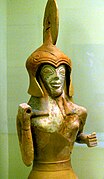
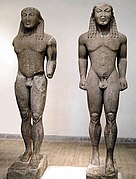









![Vaso Mikonos, un pithos (πίθος -para almacenar grano y, en su caso, fermentarlo-) decorado al relieve, que presenta la primera representación conocida del caballo de Troya. Mikonos (ca. 670 a. C.)[24]](https://upload.wikimedia.org/wikipedia/commons/thumb/5/51/Mykonos_vase.jpg/229px-Mykonos_vase.jpg)
![Vaso Chigi, un olpe (ολπη -jarra, más pequeña que el oinokhoe-) protocorintio (ca. 650 a. C.) hallado en una tumba etrusca.[25]](https://upload.wikimedia.org/wikipedia/commons/thumb/9/99/Hoplites_Chigi_Vase.PNG/268px-Hoplites_Chigi_Vase.PNG)

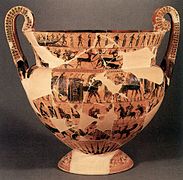

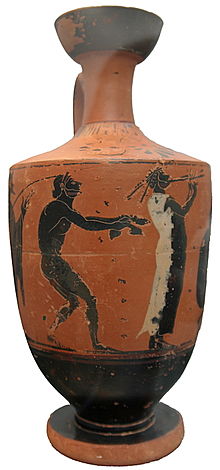
![Aquiles y Áyax jugando a los dados, en un ánfora de cerámica de figuras negras de Exequias. Hacia 540 a. C.[43]](https://upload.wikimedia.org/wikipedia/commons/thumb/e/e6/Akhilleus_Aias_MGEt_16757.jpg/271px-Akhilleus_Aias_MGEt_16757.jpg)
![Crátera de Eufronio (cerámica de figuras rojas de Eufronio, hacia 515 a. C.). La escena representa al cuerpo de Sarpedón sostenido por Eros y Tánatos, ante Hermes.[44]](https://upload.wikimedia.org/wikipedia/commons/thumb/5/59/Euphronios_krater_side_A_MET_L.2006.10.jpg/270px-Euphronios_krater_side_A_MET_L.2006.10.jpg)
![Ánfora de cerámica de figuras negras, que representa la disputa entre Apolo y Heracles por el trípode de Delfos. Relacionada con el denominado Grupo de Toronto 305. Hacia 510 a. C.[45]](https://upload.wikimedia.org/wikipedia/commons/thumb/6/67/Apollo_Herakles_tripod_Louvre_F231.jpg/229px-Apollo_Herakles_tripod_Louvre_F231.jpg)
